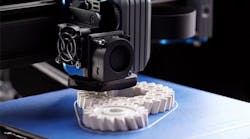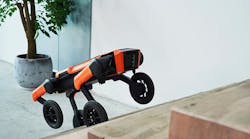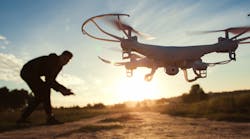I’m writing this note from the future.
Currently, I am standing in my backyard, dictating this text wirelessly to a powerful artificial intelligence platform running on a micro-supercomputer. At the same time, a semi-autonomous flying robot is hovering just over my head, capturing the whole experience, which I am watching in 3D, hi-def virtual reality.
Thinking of it that way, this might be the coolest thing I have ever done. But standing out here, honestly it feels pretty mundane.
This AI system is just Siri, which is running on my iPhone and transcribing the text (roughly) into a free note-taking app. The semi-autonomous robot is a cheap toy drone shaped like a butterfly that my 6-year old is piloting. And the fancy virtual reality goggles? Made of cardboard.
This should be an amazing experience. But I find myself less amazed by the capabilities I am using than I am of the mundanity of the experience. These are all cheap technologies, widely available, which my daughter and I are operating without any training or experience.
This is how far we’ve come in the consumer world.
Five years ago, this whole thing would’ve been science-fiction nonsense. Just one technological impossibility after another. Ask me five years ago if I let my 6-year-old pilot a helicopter? Unthinkable. Ask me if I would ever own VR goggles? Impossible.
And yet here we are.
This is the context in which I read John Hitch’s cover story in our March issue. Not in the context of the generally conservative world of manufacturing technology. Not in the context of slow moving regulations safety issues that go along with new innovation and tools. But in the context our everyday reality.
Drones are cool and easy to fly. Cameras are small and produce amazing quality. Manufacturing is in need of new solutions that can easily boost quality. That’s our context.
And in that context, I find little room to argue with John’s assertions about the potential benefits of drones in the manufacturing setting—or across the whole supply chain for that matter. It seems inevitable; it seems like the natural course.
So forget the big stories: 7-Eleven delivering packages in Reno or Amazon Air delivering packages within minutes of order. Forget the potential, as John imagines in his story, for inter-plant part delivery.
I’m looking at my own backyard. Artificial intelligence in my back pocket, wireless communication, a child operating an impossibly sophisticated toy. This is the fodder for innovation. It’s all here, all packaged and ready, waiting for someone to put it to use.
This is what the future looks like. And we’re living it right now, easily and unnoticed. It’s already almost boring. The kid wants to go play on the swing instead.










